Saws Older Belt
Driven
 This
saw is from the 1930's. The interesting things about this saw are that the drive
pulley is running the rear link arm, where most saws the drive is off of the
lower arm of the saw. Also to cut bevels on the saw the table remains fixed,
then just to the back of the table, the frame and arms pivot as one solid unit,
which seems that the motor would need to pivot too. Definately not a style I
have ever seen before.
This
saw is from the 1930's. The interesting things about this saw are that the drive
pulley is running the rear link arm, where most saws the drive is off of the
lower arm of the saw. Also to cut bevels on the saw the table remains fixed,
then just to the back of the table, the frame and arms pivot as one solid unit,
which seems that the motor would need to pivot too. Definately not a style I
have ever seen before.
 Just another old saw that was probably designed to be used a motor, or mounted on a foot treadle frame.
Just another old saw that was probably designed to be used a motor, or mounted on a foot treadle frame.
 I
would guess this a saw built in the 40's.The pulley is two pieces of stamped
sheetmetal that are riveted together to make the complete pulley.
I
would guess this a saw built in the 40's.The pulley is two pieces of stamped
sheetmetal that are riveted together to make the complete pulley.

 This Gibbs has the hand
crank still in place.
This Gibbs has the hand
crank still in place.
 This saw I guess would have been made about the 40's. It has a small black tag, just above the lower arm on the rear support, that has Gibb's Mgr. on it. This saw was designed to be driven by a motor and belt, like a round leather belt. It is mostly wood, but the red pulley is lightweight steel riveted together from two halves.
This saw I guess would have been made about the 40's. It has a small black tag, just above the lower arm on the rear support, that has Gibb's Mgr. on it. This saw was designed to be driven by a motor and belt, like a round leather belt. It is mostly wood, but the red pulley is lightweight steel riveted together from two halves.
 The Beaver saw mfg. By Hudson Mfg. Co. in Detroit. My guess would be that it was made in the 30's.
The Beaver saw mfg. By Hudson Mfg. Co. in Detroit. My guess would be that it was made in the 30's.

 These
are an all wood saw frame. It looks to have been a production made saw.
These
are an all wood saw frame. It looks to have been a production made saw.
 A vintage Walker -Turner saw.
A vintage Walker -Turner saw.
 Another Walker-Turner that has a wood table built aver it. This is one of
the earlier vintage saws because the arms are all wood, just the frame is
cast.
Another Walker-Turner that has a wood table built aver it. This is one of
the earlier vintage saws because the arms are all wood, just the frame is
cast.
 This is an old one. Looks to have a motor mount bracket on the rear, might have been a flat belt that drove the big flywheel pulley at the side . Or the motor may have had a rubber faced wheel that just made contact with the large pulley, and no belt. Guessing this was made in the 30's.
This is an old one. Looks to have a motor mount bracket on the rear, might have been a flat belt that drove the big flywheel pulley at the side . Or the motor may have had a rubber faced wheel that just made contact with the large pulley, and no belt. Guessing this was made in the 30's.
 Old saw that was motor driven, but still had wood arms. I would guess this saw was made in the 40's.
Old saw that was motor driven, but still had wood arms. I would guess this saw was made in the 40's.
 I bought this saw from
ebay.
Was listed as coming from a museum. The pulley appears to be made from lead
babbit.
I bought this saw from
ebay.
Was listed as coming from a museum. The pulley appears to be made from lead
babbit.
I'm sure this saw was handmade, maybe in the early 1900's. Has an
very interesting drive arrangement on it, that I have not seen anything
comparable to.
 Another
wood framed saw, painted red, but no brand markings on this one.
Another
wood framed saw, painted red, but no brand markings on this one.
 This saw is an Atlas
made by F. A. Smith Mfg. in Rochester , NY. Designed for a belt drive from your
motor.
This saw is an Atlas
made by F. A. Smith Mfg. in Rochester , NY. Designed for a belt drive from your
motor.



There are no markings on
this saw but I would guess it the early 1900.
The two pictures above are the top and bottom of the arm to show the very unusual drive system used on
this saw. There was no pulley on the saw so I am unsure of how the saw was
driven.
 This saw is marked
'Searjeant Metal Products, Rochester , N. Y. My guess would be that it was made in the 30-40's. It has a small throat but plenty of height under the arm.
Sheridan Cummings email me and has an advertisement in a November 1947
issue of Mechanics Illustrated, pg.164 that is clearly this machine. Sold
for $12.50 at that time.
This saw is marked
'Searjeant Metal Products, Rochester , N. Y. My guess would be that it was made in the 30-40's. It has a small throat but plenty of height under the arm.
Sheridan Cummings email me and has an advertisement in a November 1947
issue of Mechanics Illustrated, pg.164 that is clearly this machine. Sold
for $12.50 at that time.
 A set of three. A scrollsaw, drill press. And grinder.
A set of three. A scrollsaw, drill press. And grinder.
 This
is a bench mounted saw that was patented in 1872. This saw was marketed by
Pomroy under the name brand of " House Saw"
This
is a bench mounted saw that was patented in 1872. This saw was marketed by
Pomroy under the name brand of " House Saw"
 An
old belt driven bench top saw. This is like the Mongomery Wards but there is not
a name on it.
An
old belt driven bench top saw. This is like the Mongomery Wards but there is not
a name on it.

Another old belt driven saw. Maker unknown because there are no markings on
the saw.
 Unknown
maker of a stamped metal frame saw.
Unknown
maker of a stamped metal frame saw.
 This
saw has the " Velocipede " name cast into the side of the frame
. The very interesting thing on this saw is the the arms arm cast metal.
But they bolt to the wood c-frame at the back of the saw, so there is about
3" of wood frame between the upper and lower arm.
This
saw has the " Velocipede " name cast into the side of the frame
. The very interesting thing on this saw is the the arms arm cast metal.
But they bolt to the wood c-frame at the back of the saw, so there is about
3" of wood frame between the upper and lower arm.
 This
one looks to be maybe homemade. The eccentric-axle looks like an automotive
valve. That is mounted in bearing blocks with large oil reservoirs, with screw
on caps. A very well built saw.
This
one looks to be maybe homemade. The eccentric-axle looks like an automotive
valve. That is mounted in bearing blocks with large oil reservoirs, with screw
on caps. A very well built saw.

I have others that seem to be this same model of saw. Must have been
manufactured at some time.
 Patent pending by J & H Metal Products, Rochester, N. Y.
Patent pending by J & H Metal Products, Rochester, N. Y.

Unknown maker on another old belt driven saw.
 Another bench top belt driven saw. This one has a large heavy
Another bench top belt driven saw. This one has a large heavy
cast pulley, that I guess was to help add torque to the saw.
 Made
by Seargent Metal Products of Rochester, N. Y.
Made
by Seargent Metal Products of Rochester, N. Y.
 A
Walker Turner donated by Dick Meuler. This was his dad's saw.
A
Walker Turner donated by Dick Meuler. This was his dad's saw.

There are no names or marks on this saw.
It has a very short cutting height , but a deep throat,
so I can not even guess what this saw was designed for.

This is an interesting saw because it has no pulley.
Looks like you tied a rope to the part hanging over the
table, then used your foot to pull the blade down. T
he top arm is spring loaded to return the blade upward.
One stroke with the foot to make one cut with the blade,
had to be slow cutting.
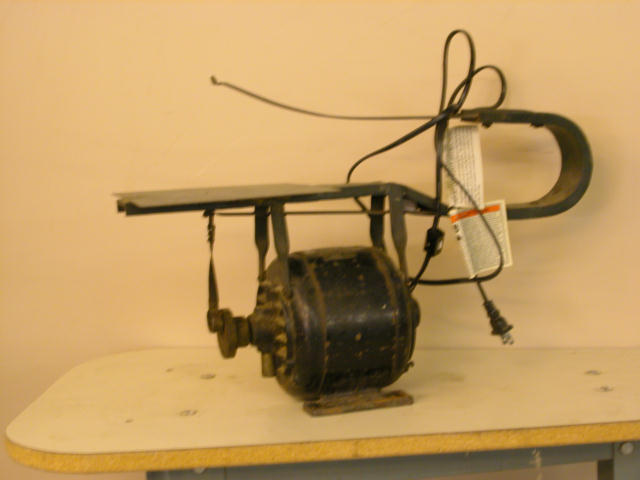 Found
one with a motor so now I know what it was for sure.
Found
one with a motor so now I know what it was for sure.
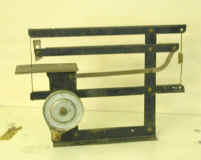 All metal saw,
unknown maker.
All metal saw,
unknown maker.
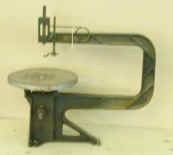 Another Wards saw
Another Wards saw
 Unknown
belt drive saw.
Unknown
belt drive saw.
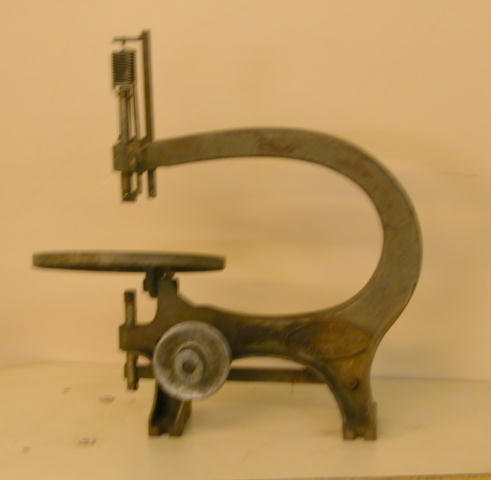 Boice
Crane saw.
Boice
Crane saw.
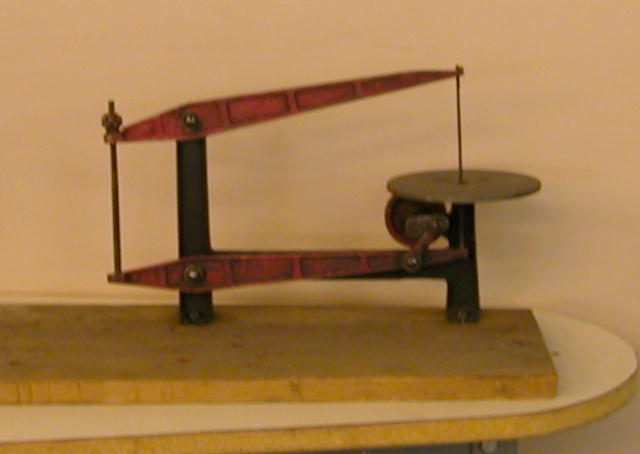 Unknown
type of saw.
Unknown
type of saw.
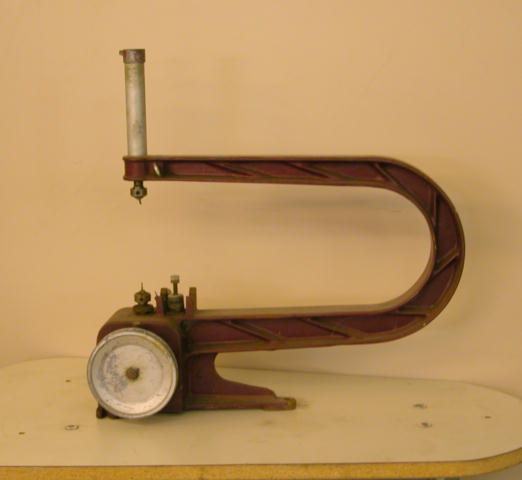 Wards
type old saw.
Wards
type old saw.
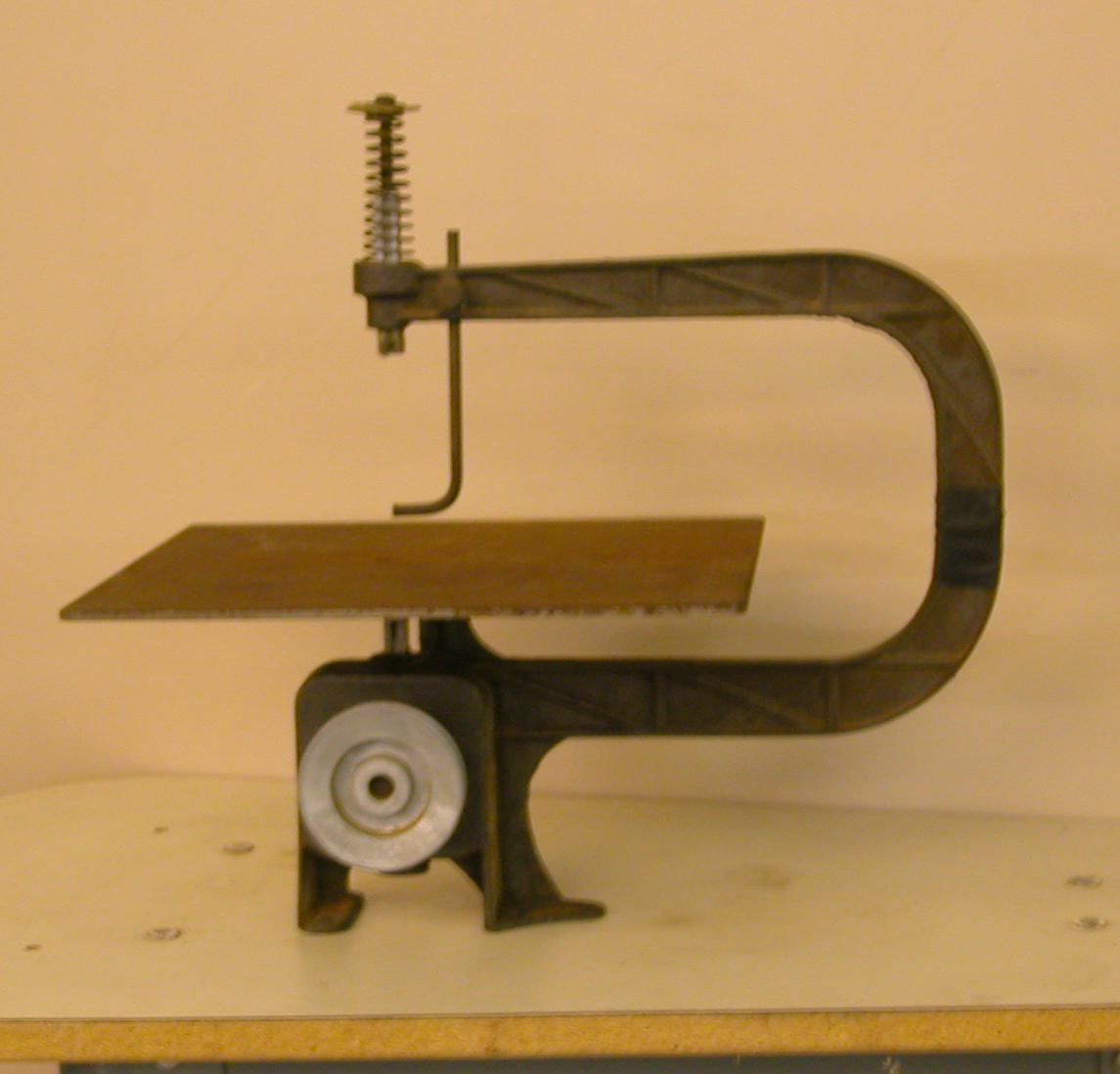 Another
Wards type.
Another
Wards type.
Next
CONTINUED ON NEXT PAGE
 This
saw is from the 1930's. The interesting things about this saw are that the drive
pulley is running the rear link arm, where most saws the drive is off of the
lower arm of the saw. Also to cut bevels on the saw the table remains fixed,
then just to the back of the table, the frame and arms pivot as one solid unit,
which seems that the motor would need to pivot too. Definately not a style I
have ever seen before.
This
saw is from the 1930's. The interesting things about this saw are that the drive
pulley is running the rear link arm, where most saws the drive is off of the
lower arm of the saw. Also to cut bevels on the saw the table remains fixed,
then just to the back of the table, the frame and arms pivot as one solid unit,
which seems that the motor would need to pivot too. Definately not a style I
have ever seen before.


























 Patent pending by J & H Metal Products, Rochester, N. Y.
Patent pending by J & H Metal Products, Rochester, N. Y.





 Found
one with a motor so now I know what it was for sure.
Found
one with a motor so now I know what it was for sure. All metal saw,
unknown maker.
All metal saw,
unknown maker. Another Wards saw
Another Wards saw Unknown
belt drive saw.
Unknown
belt drive saw. Boice
Crane saw.
Boice
Crane saw. Unknown
type of saw.
Unknown
type of saw. Wards
type old saw.
Wards
type old saw. Another
Wards type.
Another
Wards type.